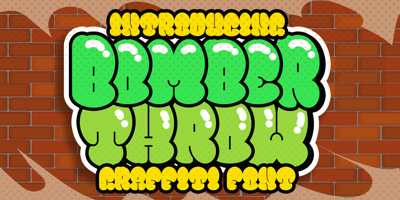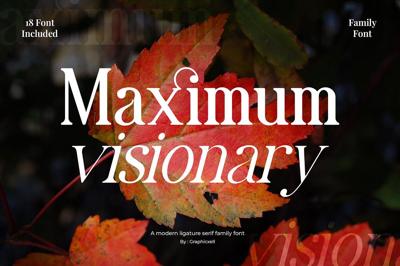Typography That Converts: Fonts That Boost Sales
Typography That Converts: Fonts That Boost Sales
Typography directly influences purchasing decisions, conversion rates, and revenue generation in ways that most businesses never realize. While beautiful fonts capture attention, conversion-focused typography goes beyond aesthetics to leverage psychological triggers, trust-building elements, and behavioral science principles that motivate customers to take action. Understanding how specific font choices impact the customer journey from awareness to purchase enables businesses to optimize their typography for measurable sales improvement and revenue growth.
The Psychology of Conversion-Driven Typography
Typography psychology operates at subconscious levels where font choices trigger immediate emotional and behavioral responses that influence purchasing decisions before customers consciously evaluate products or services.
Trust and Credibility Foundations: Certain fonts immediately establish trust and credibility that reduce customer hesitation during purchase consideration. Professional, clean fonts signal reliability and competence that make customers more comfortable sharing payment information and committing to purchases.
Urgency and Action Motivation: Strategic typography creates psychological urgency that motivates immediate action rather than delayed consideration. Bold, confident fonts suggest limited-time opportunities while creating emotional pressure that drives conversion completion.
Cognitive Load Reduction: Conversion-optimized fonts reduce mental effort required to process information, making purchase decisions feel easier and more natural. When customers struggle to read or understand content, they often abandon purchase processes rather than invest additional mental energy.
Decision Confidence Building: Typography that enhances information clarity and logical presentation builds customer confidence in purchase decisions. Clear hierarchies and readable fonts help customers feel informed and certain about their choices, reducing abandonment rates.
E-commerce Typography for Maximum Conversion
E-commerce platforms provide measurable environments where typography changes directly correlate with conversion rate improvements and revenue increases.
Product Description Optimization: Product descriptions require fonts that enhance feature comprehension while building desire and confidence. Sans-serif fonts typically perform better for product specifications due to superior screen readability, while selective use of serif fonts can add credibility to quality claims.
Open Sans consistently delivers excellent results in e-commerce applications due to its exceptional readability and professional appearance that builds trust without overwhelming product information. This free font provides the clarity needed for complex product descriptions while maintaining appealing visual presentation.
Call-to-Action Typography: "Add to Cart" and "Buy Now" buttons benefit from bold, confident fonts that suggest easy, secure transactions. Button text should stand out clearly while maintaining readability under various viewing conditions and screen sizes.
Roboto Bold provides excellent call-to-action performance with its confident appearance and optimized screen rendering. This free font creates urgency while remaining highly legible across different devices and browsers.
Price Display Strategy: Price typography significantly influences perceived value and purchase motivation. Larger prices can suggest premium quality, while smaller prices may emphasize affordability. The key lies in aligning price presentation with overall brand positioning.
Checkout Process Fonts: Checkout pages require typography that reduces anxiety and builds confidence in transaction security. Clean, authoritative fonts help customers feel secure while completing sensitive payment processes.
Source Sans Pro excels in checkout applications where trust and clarity become paramount. This professional free font communicates competence and security that reduces checkout abandonment rates.
Landing Page Typography for Lead Generation
Landing pages designed for lead generation require typography that guides visitors through persuasive content toward conversion actions like email signup, quote requests, or consultation bookings.
Headline Hierarchy and Impact: Landing page headlines must immediately communicate value propositions while guiding attention toward conversion elements. Strategic font weight and sizing create visual paths that lead visitors toward desired actions.
Montserrat provides geometric precision that works excellently for landing page headlines requiring modern authority. This free font creates strong visual impact while maintaining professional credibility essential for lead generation.
Benefit Communication: Typography that enhances benefit presentation and feature explanation builds visitor interest and conversion motivation. Clear, scannable text formats help visitors quickly understand value propositions without excessive reading effort.
Social Proof Integration: Testimonials and reviews require typography that enhances credibility while remaining easily readable. Italic fonts can distinguish quotes from regular content while maintaining authenticity and trustworthiness.
Form Field Optimization: Contact forms and lead capture elements benefit from clean, simple fonts that reduce completion friction while building confidence in data security and professional handling.
Sales Page Typography Psychology
Long-form sales pages require sophisticated typography strategies that maintain reader engagement while building persuasive momentum toward purchase completion.
Attention Retention Strategies: Extended sales content needs typography variety that prevents reading fatigue while maintaining consistent brand presentation. Strategic use of font weights, sizes, and spacing creates visual rhythm that supports sustained attention.
Scarcity and Urgency Communication: Typography can amplify scarcity messaging and time-sensitive offers through strategic boldness and visual prominence. However, overuse of urgent typography can appear manipulative and reduce trust.
Objection Handling Typography: Sections addressing customer concerns and objections benefit from authoritative, trustworthy fonts that build confidence in solutions and reduce purchase hesitation.
Guarantee and Risk Reversal: Money-back guarantees and risk reversal offers require typography that emphasizes security and confidence while remaining legally compliant and professionally appropriate.
Mobile Commerce Typography Optimization
Mobile commerce presents unique typography challenges where small screens and touch interfaces significantly impact conversion performance and user experience.
Touch-Friendly Typography: Mobile conversion requires fonts and sizing that work effectively with touch navigation and small screen viewing. Buttons and clickable elements need adequate sizing and spacing to prevent accidental touches that frustrate users.
Thumb-Friendly Button Design: Mobile call-to-action buttons require typography that remains readable while fitting comfortably within thumb-reach areas. Strategic font sizing ensures readability without requiring zoom or strain.
Single-Handed Usage Optimization: Typography layouts must work effectively for single-handed mobile usage patterns where thumb positioning influences interaction possibilities and conversion completion rates.
Loading Speed Considerations: Mobile conversion rates suffer when fonts load slowly or cause layout shifts. Free font services like Google Fonts provide optimized mobile delivery that ensures fast loading without compromising visual quality.
A/B Testing Typography for Conversion Optimization
Systematic testing reveals which typography choices actually improve conversion rates rather than relying on aesthetic preferences or design assumptions.
Testing Methodology: Effective conversion testing isolates typography variables while controlling other factors that might influence results. Test single font changes rather than complete design overhauls to identify specific typography impact.
Key Performance Indicators: Monitor conversion rates, click-through rates, time on page, and bounce rates to understand how typography changes influence user behavior and business outcomes.
Statistical Significance: Ensure adequate sample sizes and testing duration to achieve statistically significant results that provide reliable insights for typography decision-making.
Iterative Optimization: Use testing results to inform additional typography experiments that continuously improve conversion performance over time rather than seeking single perfect solutions.
Industry-Specific Conversion Typography
Different industries require typography approaches that align with customer expectations and purchasing behaviors specific to their markets and decision-making processes.
SaaS and Technology: Software and technology companies benefit from clean, modern fonts that communicate innovation and reliability. Customers need confidence in technical competence and ongoing support capabilities.
Inter provides cutting-edge typography that suggests technological sophistication while maintaining excellent readability across all digital applications. This free font communicates innovation leadership that technology customers expect.
Healthcare and Medical: Healthcare conversions require typography that builds trust and communicates professional competence while remaining accessible and non-intimidating to anxious patients.
Professional Services: Legal, accounting, and consulting services need typography that establishes authority and expertise while building client confidence in service quality and professional competence.
Financial Services: Banks, investment firms, and financial advisors require typography that communicates security, stability, and professional competence essential for financial decision-making.
E-learning and Education: Educational content and course sales benefit from typography that enhances learning and comprehension while building confidence in educational value and instructor expertise.
Typography and Pricing Psychology
Font choices significantly influence price perception and willingness to pay, making typography strategy essential for revenue optimization and pricing effectiveness.
Premium Pricing Typography: Luxury and premium-priced products benefit from elegant, sophisticated fonts that justify higher prices through perceived quality and exclusivity. Serif fonts often support premium positioning better than casual alternatives.
Value Pricing Communication: Budget-focused businesses need typography that emphasizes value and affordability without appearing cheap or unprofessional. Clean, straightforward fonts communicate honest value rather than luxury positioning.
Price Anchoring Support: Typography hierarchy can support price anchoring strategies by emphasizing regular prices while de-emphasizing sale prices, or vice versa, depending on positioning objectives.
Payment Plan Presentation: Subscription services and payment plans benefit from typography that makes monthly prices appear manageable while building confidence in ongoing value delivery.
Emotional Typography for Brand Connection
Conversion-focused typography must balance logical presentation with emotional connection that motivates purchase decisions through feeling as well as reasoning.
Brand Personality Alignment: Typography choices must align with brand personality while optimizing conversion performance. The most effective approach balances brand consistency with conversion optimization rather than sacrificing either element.
Customer Journey Integration: Different stages of the customer journey may require different typography approaches that support awareness, consideration, and decision-making phases with appropriate psychological triggers.
Storytelling Support: Brand stories and customer success narratives benefit from typography that enhances emotional connection while maintaining credibility and professional presentation.
Conversion Typography Implementation
Successfully implementing conversion-focused typography requires systematic approaches that test, measure, and optimize typography choices based on actual performance data.
Gradual Testing Approach: Implement typography changes gradually through systematic testing rather than complete overhauls that make it difficult to identify specific improvement factors.
Cross-Platform Consistency: Ensure conversion-optimized typography works consistently across all platforms and devices where customers might encounter your brand and make purchase decisions.
Team Training and Guidelines: Develop typography guidelines that help team members make conversion-focused font choices without requiring deep expertise in psychology or conversion optimization.
Ongoing Optimization: Conversion typography requires ongoing attention and optimization as customer preferences, technology, and competitive landscapes continue evolving.
Measuring Typography Conversion Impact
Successful conversion typography requires measurable outcomes that demonstrate return on investment and guide ongoing optimization efforts.
Revenue Attribution: Track revenue changes following typography optimizations to understand direct financial impact of font choices on business performance.
Conversion Funnel Analysis: Monitor conversion rates at different funnel stages to identify where typography improvements have the greatest impact on customer progression toward purchase.
Customer Feedback Integration: Collect customer feedback about readability, trust perception, and overall experience to validate quantitative metrics with qualitative insights.
Competitive Analysis: Study competitor typography strategies and performance to identify opportunities for differentiation and improvement in your own conversion optimization efforts.
Conclusion: Typography as Revenue Driver
Typography represents one of the most underutilized conversion optimization tools available to modern businesses. Strategic font choices consistently improve sales performance, customer engagement, and revenue generation when implemented with understanding of psychological triggers and customer behavior patterns.
Remember that conversion-focused typography serves business objectives rather than purely aesthetic goals. The most beautiful fonts mean nothing if they don't motivate customers to take desired actions and complete purchase processes.
Whether using premium fonts or carefully selected free font alternatives, focus on typography choices that build trust, reduce friction, and guide customers toward conversion completion. Systematic testing and optimization ensure typography investments deliver measurable returns rather than just visual appeal.
Start evaluating your current typography through the lens of conversion optimization rather than aesthetic preference alone. Small typography improvements often yield disproportionately large improvements in sales performance and customer engagement.
The evidence is clear: typography directly impacts conversion rates and revenue generation. Businesses that master conversion-focused typography gain significant competitive advantages through improved sales performance and customer experience optimization.



